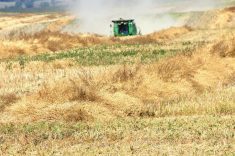Damage from snow, rain and spring flooding is beginning to add up for Saskatchewan rural municipalities.
Arlynn Kurtz, reeve of the RM of Fertile Belt in east-central Saskatchewan, said the area has received more than 200 millimetres of water since April 1, not including spring runoff.
Roads are paying the price.
“We have six major washouts,” he said May 18.
“We probably have another 50 problem areas where small culverts are washed out, collapsed, water running over the road, roads closed. We have roads that are pretty much impassable.”
Read Also

Alberta researcher helps unlock the economics of farming
Lethbridge Polytechnic researcher helping agriculture producers with decision-making tools in economic feasibility
That includes a road in the hills leading into the Qu’Appelle Valley that is covered in 10 metres of soil from a collapsed hillside.
Kurtz estimates the repair cost at more than $1 million and said there could be more damage that hasn’t been found yet. Engineers are recommending culverts be checked once the water quits running.
Reeve Wilfred Schultz faces a similar situation next door in the RM of Grayson.
“Our roads are not too bad,” he said. “There’s a few closed, a few washed out. It’s our farmers. They can’t get into the fields.”
Both reeves say less land will likely be seeded this year than last.
“If we get 50 percent in, we’re lucky,” said Schultz.
Kurtz agreed.
He said farmers are becoming concerned about their eligibility for the unseeded acreage benefit from Saskatchewan Crop Insurance Corp. They wonder if they will receive money if the field could have been seeded but they couldn’t reach it with their equipment.
Agriculture minister Bob Bjornerud said that topic is under discussion. As it stands, the benefit wouldn’t apply.
“We’re looking at it and seeing if we need to make some adjustments there,” he said. “I’m sure that is a problem.”
He said it is obvious farmers can’t move equipment on back roads that are under water or that have been cut.
As well, roads have to be wide enough to accommodate the size of modern farm equipment.
Bjornerud said a decision would be made quickly. The unseeded acreage benefit kicks in June 25.
However, he hopes the weather will co-operate.
“Crop insurance is one thing but if your bins are full, that’s a better thing,” he said.
Meanwhile, RMs that have declared disaster areas and applied for eligibility under the Provincial Disaster Assistance Program will wait to see how repairs progress.
Municipalities pay a deductible of .1 percent of their taxable assessments. Unlike claims for principal residences, claims made by municipalities are not limited to a maximum amount.
Fertile Belt and Grayson are among RMs that have declared and are eligible. Last week, a contractor was installing a new 25 by 2.5 metre culvert in Fertile Belt, the first of six washouts to be fixed.
Schultz said his municipality was already building a new office and shop before flooding destroyed its roads.
“I don’t think our ratepayers can afford everything,” he said.
The RM hasn’t raised its mill rate in 15 years, but that could be an option, he added.
“Culverts aren’t cheap. A five-foot culvert, 60 feet or 45 feet, is around $15,000, and that’s just for the culvert.”
Canada Culvert vice-president Jason Johnston said the company is swamped because of flooding.
“We have a couple long-time employees and they said this is probably the most work since they opened in ’84,” he said.
“It’s all coming at one time.”
He said his company has been able to keep up with demand.
“We’re still offering three to five day deliveries on stock items and we’re subsidizing orders from Ponoka, Alta., and Winnipeg, Man., just to keep up with the flooding issues.”
RMs that require special orders, such as longer lengths of pipe, could wait a week or two.
Johnston said the next six weeks will be the busiest as the company fills orders, mainly from eastern Saskatchewan and Manitoba.
“Our philosophy is RMs have supported us for a long time and now it’s time for us to support the RMs,” he said.
The Saskatchewan Heavy Construction Association has also adopted that philosophy, said president Shantel Lipp.
She said many contractors are waiting to get to work because of wet conditions and because much of the highways work has not yet been tendered.
As a result, they are available to help RMs do their work.
“Everybody’s facing the same situation,” she said.
The association has supplied a list to the highways ministry of what capacity it has available and where.
Lipp said the best way for communities to find a contractor is to call the association office. That way they have access to 200 potential builders instead of a handful.
“Tell us what you need and we’ll make it work,” she said.















